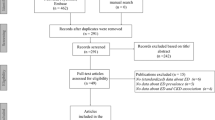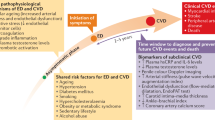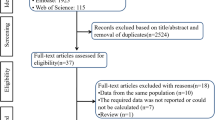Abstract
The efficacy of phosphodiesterase type 5 inhibitors (PDE5i) in patients with erectile dysfunction (ED) and undiagnosed prediabetes (PreDM) has been scantly analysed. We aimed to assess rates of and predictors of response to oral treatment in a cohort of ED men naïve for PDE5i with either normo-glycaemia or PreDM or diabetes mellitus (DM). Complete data from 466 men were analysed. Comorbidities were scored with the Charlson Comorbidity Index (CCI). Patients completed the International Index of Erectile Function (IIEF) at baseline and after 3 months of PDE5i treatment. Treatment response was evaluated using the minimal clinically important difference (MCID) (mild: +2; moderate: +5; severe: +7 from baseline IIEF-EF). PreDM status was defined as for the American Diabetes Association (2015) criteria. Descriptive statistics and logistic regression models tested the association between clinical predictors and MCID response. Overall, 253 (56.7%), 105 (23.5%) and 88 (19.7%) patients had normo-glycaemia (=controls), PreDM and DM, respectively. Diabetic and PreDM men were older, had higher BMI, higher CCI scores and lower total testosterone (tT) (all p < 0.01) compared to controls. Median baseline IIEF-EF was lower both in PreDM (14.0 vs. 18.0; p < 0.05) and DM patients (10.0 vs. 18.0; p < 0.001) than in controls. IIEF-EF improved in all groups after treatment (all p < 0.001), but scores were higher in controls compared to both PreDM and DM men at 3-mos assessment (26.0 vs. 20.0 vs. 17.5, respectively; all p < 0.001). Controls more frequently achieved significant MCID than both PreDM and DM patients (65.3 vs. 22.9 vs. 11.8%, respectively; p < 0.01). Age (p < 0.001), baseline IIEF-EF (p < 0.001), and DM status (p = 0.02) were independently associated with MCID. In conclusion, patients with undiagnosed PreDM depicted lower rates of response to PDE5i than normoglycemic men. These findings suggest that even milder forms of glucose impairment are associated with a poorer PDE5i effectiveness in men with ED.
This is a preview of subscription content, access via your institution
Access options
Subscribe to this journal
Receive 8 print issues and online access
$259.00 per year
only $32.38 per issue
Buy this article
- Purchase on Springer Link
- Instant access to full article PDF
Prices may be subject to local taxes which are calculated during checkout


Similar content being viewed by others
References
Kouidrat Y, Pizzol D, Cosco T, Thompson T, Carnaghi M, Bertoldo A, et al. High prevalence of erectile dysfunction in diabetes: a systematic review and meta-analysis of 145 studies. Diabet Med. 2017;34:1185–92.
Maseroli E, Corona G, Rastrelli G, Lotti F, Cipriani S, Forti G, et al. Prevalence of endocrine and metabolic disorders in subjects with erectile dysfunction: a comparative study. J Sex Med. 2015;12:956–65.
Hatzimouratidis K, Salonia A, Adaikan G, Buvat J, Carrier S, El-Meliegy A, et al. Pharmacotherapy for erectile dysfunction: recommendations from the Fourth International Consultation for Sexual Medicine (ICSM 2015). J Sex Med. 2016;13:465–88.
Mulhall JP, Carlsson M, Stecher V, Tseng LJ. Predictors of erectile function normalization in men with erectile dysfunction treated with placebo. J Sex Med. 2018;15:866–72.
Tabàk AG, Herder C, Rathmann W, Brunner EJ, Kivimaki M. Prediabetes: a high-risk state for diabetes development. Lancet. 2012;379:2279–90.
Rhee SY, Woo JT. The prediabetic period: review of clinical aspects. Diabetes Metab J. 2011;35:107–16.
Corona G, Rastrelli G, Balercia G, Lotti F, Sforza A, Monami M, et al. Hormonal association and sexual dysfunction in patients with impaired fasting glucose: a cross-sectional and longitudinal study. J Sex Med. 2012;9:1669–80.
Boeri L, Capogrosso P, Pederzoli F, Ventimiglia E, Frego N, Chierigo F, et al. Unrecognized prediabetes is highly prevalent in men with erectile dysfunction-results from a cross-sectional study. J Sex Med. 2018;15:1117–24.
Hatzimouratidis K, Hatzichristou D. How to treat erectile dysfunction in men with diabetes: from pathophysiology to treatment. Curr Diab Rep. 2014;14:545.
Corona G, Rastrelli G, Burri A, Serra E, Gianfrilli D, Mannucci E, et al. First-generation phosphodiesterase type 5 inhibitors dropout: a comprehensive review and meta-analysis. Andrology. 2016;4:1002–9.
Noyman I, Marikovsky M, Sasson S, Stark AH, Bernath K, Seger R, et al. Hyperglycemia reduces nitric oxide synthase and glycogen synthase activity in endothelial cells. Nitric Oxide. 2002;7:187–93.
Booth G, Stalker T, Lefer A, Scalia R. Elevated ambient glucose induces acute inflammatory events in the microvasculature: effects of insulin. Am J Physiol Endocrinol Metab. 2001;280:E848–E856.
Graier WF, Posch K, Fleischhacker E, Wascher TC, Kostner GM. Increased superoxide anion formation in endothelial cells during hyperglycemia: an adaptive response or initial step of vascular dysfunction? Diabetes Res Clin Pract. 1999;45:153–60.
Penson D, Latini D, Lubeck D, Wallace K, Henning J, Lue T. Do impotent men with diabetes have more severe erectile dysfunction and worse quality of life than the general population of impotent patients? Results from the Exploratory Comprehensive Evaluation of Erectile Dysfunction(ExCEED) database. Diabetes Care. 2003;26:1093–9.
McCabe MP, Sharlip ID, Atalla E, Balon R, Fisher AD, Laumann E, et al. Definitions of sexual dysfunctions in women and men: a consensus statement from the Fourth International Consultation on Sexual Medicine 2015. J Sex Med. 2016;13:135–43.
Charlson ME, Pompei P, Ales KL, MacKenzie CR. A new method of classifying prognostic comorbidity in longitudinal studies: development and validation. J Chronic Dis. 1987;40:373–83.
National Institute of Alcohol Abuse and Alcoholism. The Physicians’ guide to helping patients with alcohol problems. Washington, DC: U.S. Department of Health and Human Services, National Institutes of Health; 1995. http://mpcmh.org/wp-content/uploads/2017/12/NIAAA_Clinicians_Guide_AandD_Screening.pdf Accessed September 03, 2018
Rosen RC, Riley A, Wagner G, Osterloh IH, Kirkpatrick J, Mishra A. The International Index of Erectile Function (IIEF): a multidimensional scale for assessment of erectile dysfunction. Urology. 1997;49:822–30.
Cappelleri JC, Rosen RC, Smith MD, Mishra A, Osterloh IH. Diagnostic evaluation of the erectile function domain of the International Index of Erectile Function. Urology. 1999;54:346–51.
Rosen RC, Allen KR, Ni X, Araujo AB. Minimal clinically important differences in the erectile function domain of the International Index of Erectile Function scale. Eur Urol. 2011;60:1010–6.
Khera M, Adaikan G, Buvat J, Carrier S, El-Meliegy A, Hatzimouratidis K, et al. Diagnosis and treatment of testosterone deficiency: recommendations from the Fourth International Consultation for Sexual Medicine (ICSM 2015). J Sex Med. 2016;13:1787–804.
American Diabetes Association. Diagnosis and classification of diabetes mellitus. Diabetes Care. 2014;37:S81–S90.
Balhara YP, Sarkar S, Gupta R. Phosphodiesterase-5 inhibitors for erectile dysfunction in patients with diabetes mellitus: a systematic review and meta-analysis of randomized controlled trials. Indian J Endocrinol Metab. 2015;19:451–61.
Porst H, Burnett A, Brock G, Ghanem H, Giuliano F, Glina S, et al. SOP conservative (medical and mechanical) treatment of erectile dysfunction. J Sex Med. 2013;10:130–71.
Yafi FA, Jenkins L, Albersen M, Corona G, Isidori A, Goldfarb S, et al. Erectile dysfunction. Nat Rev Dis Prim. 2016;2:16003.
Cellek S, Qu W, Schmidt AM, Moncada S. Synergistic action of advanced glycation end products and endogenous nitric oxide leads to neuronal apoptosis in vitro: a new insight into selective nitrergic neuropathy in diabetes. Diabetologia. 2003;47:331–9.
Castela A, Gomes P, Silvestre R, Guardão L, Leite L, Chilro R, et al. Vasculogenesis and diabetic erectile dysfunction: how relevant is glycemic control? J Cell Biochem. 2017;118:82–91.
Castela Â, Costa C. Molecular mechanisms associated with diabetic endothelial-erectile dysfunction. Nat Rev Urol. 2016;13:266–74.
Rabijewski M, Papierska L, Kuczerowski R, Piątkiewicz P. Hormonal determinants of erectile dysfunction and lower urinary tract symptoms in middle-aged and elderly men with prediabetes. Aging Male. 2015;18:256–64.
Author information
Authors and Affiliations
Corresponding author
Ethics declarations
Conflict of interest
The authors declare that they have no conflict of interest.
Additional information
Publisher’s note: Springer Nature remains neutral with regard to jurisdictional claims in published maps and institutional affiliations.
Rights and permissions
About this article
Cite this article
Boeri, L., Capogrosso, P., Ventimiglia, E. et al. Undiagnosed prediabetes status is associated with a reduced effectiveness of phosphodiesterase type 5 inhibitors in men with erectile dysfunction. Int J Impot Res 32, 393–400 (2020). https://doi.org/10.1038/s41443-019-0149-4
Received:
Revised:
Accepted:
Published:
Issue Date:
DOI: https://doi.org/10.1038/s41443-019-0149-4
This article is cited by
-
Conservative Non-surgical Options for Erectile Dysfunction
Current Urology Reports (2023)
-
Undiagnosed prediabetes status is associated with a reduced effectiveness of phosphodiesterase type 5 inhibitors in men with erectile dysfunction
International Journal of Impotence Research (2020)



